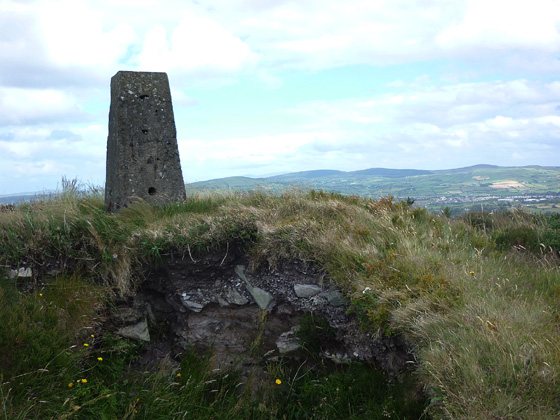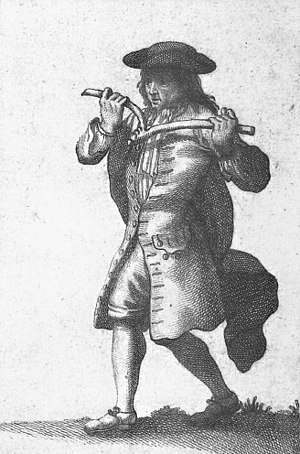'The farmer just booked us for gathering potatoes. They came round the street looking for people. We only went when we were wee tots. It was Jimmy Harron up the Castlefinn road. We went up one Monday morning, we were no age! We went into the field and asked Jimmy ‘could we get a start’ and he said ‘no we have enough.’ But when he knew who we were he called us back and we worked all week. At the end of the week he said we were the best workers. We ran down through the fields to get home again. We started about eight and finished about five and six. I think I got paid £2 10s. It was good money at the time. We just gave the money to mammy and she gave us our ice cream money or whatever. We gathered for years after, we were good workers at that stage and we could carry the baskets and all later. It was the old wooden baskets, they were heavy on their own. The wet clay stuck to them. You put the potatoes in the pit then and covered them with rushes. The farmer had the pits ready. Some made you gather the ground to make sure there were no spuds still buried. The wee spuds would have been kept for the hens. The spuds were beautiful at the time though. There were all kinds, pinks and queens and banners and roosters, golden wonders and king Edwards. The ground was marked or ‘stepped’ and the old fashion boys used to move the markers.'
'Jimmy used to bring us in for dinner around big tables and there was a huge pot of spuds and bacon and sausages. They used to bring our lunch and tea out to us as well, when you heard the whistle you’d know the dinner was ready.'
'I worked in Vincent’s café. Vincent had a big yellow Ford Capri car sitting outside every night. We used to give out bags of chips. Vincent prepared all the food, you just had to cook it. He always had certain days of the week to prepare. There was a wee foozball table and a jukebox. It was very busy, all the young ones used to sit in at night. You opened until 12 because the pubs closed in at half 11. I remember a man coming in late one night –and he says ‘I came into town at half five for bread…can you put on a fish and chips for me because it’ll be my last supper!’
'I worked in Gambles in Killygordan. It was a big going business. They had big bands, people came from everywhere to Gambles. I remember a man used to come in and he used to ask for a ‘cream of the barley and a monk by the neck’ (monk was a beer). It used to be packed out, I was still at school at the time. I got £1 a night, I worked three nights. I worked from six until half one, maybe two. Drink was all carried out to the tables there, there was no bar. You counted all the money in your head. They gave you a float at the start of the night, all the money was your responsibility. The guards used to come in but whoever was in the bar was always called ‘staff’, there was always a lot of ‘staff’ whenever the guards were around!'
'I worked in Porter’s then after I left school, and I worked in it almost until it closed. I worked up in the office. I remember our boss caught us talking and asked ‘have you nothing to do’ and one of the girls said ‘not really!’ and he says ‘well I’ll give you work to do’. I remember when it was burnt to the ground in 1979. I remember the fire brigade couldn’t get enough water at the time, they had to get it from a hand pump at the bottom of the Diamond. Everybody was watching it crying, it was a disaster, a lot of people worked there. There was nothing they could do. I remember seeing the safe falling down through the floor and breaking open, everything was destroyed, all the records were lost. Within a week the IDA got them a new premises in Lifford and they worked there for two years before they got a new factory in Castlefinn.'
'My first official job was in Mc Guckin’s factory in Ballybofey. It was the solo shirt factory as it was called. I went up on the Friday on the bus on my 14th birthday when I was told I got the job. It was a great place to work, I was doing the buttons and button holes. Leonard Mc Guckin was the owner and he was a very good man. His mother used to come over and watch us so we’d all be working, we all called her ‘Mother Mc Guckin’. We used to toast bread and cheese with the iron. After that I went to Herdsman’s when I was 18’.'
'My first job was at 14 in Jim Mc Rory’s café at the weekends. That used to big craic. If Jim was in good form the craic was good! He used to make the dinners, cabbage and bacon with a bowl of soup at the start. It was for nothing really he never made any money but he fed half the country. He used to make a big pot of soup in the wintertime and it was good.'
'I worked in Tinneys when I was about 20 and I worked there for 14 years, and my mother worked there for 21! I loved working in it, it was an old man’s bar back then. Days went in very quick and the old men used to tell yarns all day, the tears would’ve been running down my face. There used to be great craic there. They used to start off ‘young boys nowadays….’ and then they used to tell stories about what they did when they were young, you couldn’t tell half of them!'
'I worked in the ‘Squealing Pig’ in Ballindrait, I got down by bicycle. It was called after a local man who had a very high squeaky voice after a few drinks. I only worked there at weekends. My first job was in Porter’s spreading cloth. That meant laying out the cloth before it was cut into shapes. A machine went up and down the floor and you had walk behind it and level it up. Depending on what the order was. I was there for 19 years. It was a good enough job but you were doing the same thing day in and day out.'
'I worked in St. Josephs then as a carer. It was the happiest days of my life, I loved it. The atmosphere was great between the patients and the staff. Many times you worked on after the time, and you’d go in voluntary on Sundays and holidays for plays and events. Christmas was always great, there were lots of parties and a lot of the patients would have got involved in the entertainment themselves. There would have been singing and dancing, the patients loved the music.'
Contributors:
Nettie Gillespie
Sam Gallagher
Mary Mc Connell
Margo Mc Ghee







